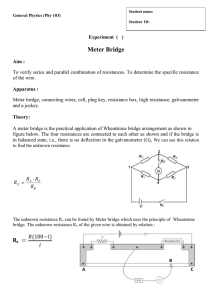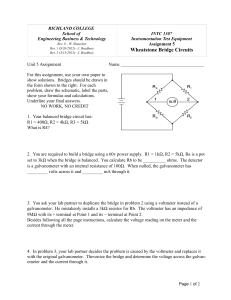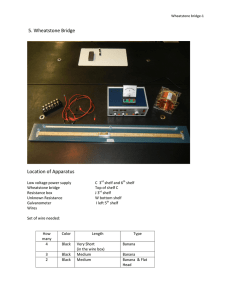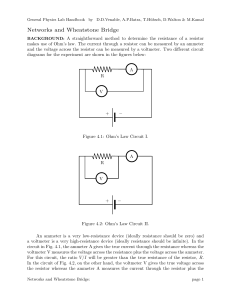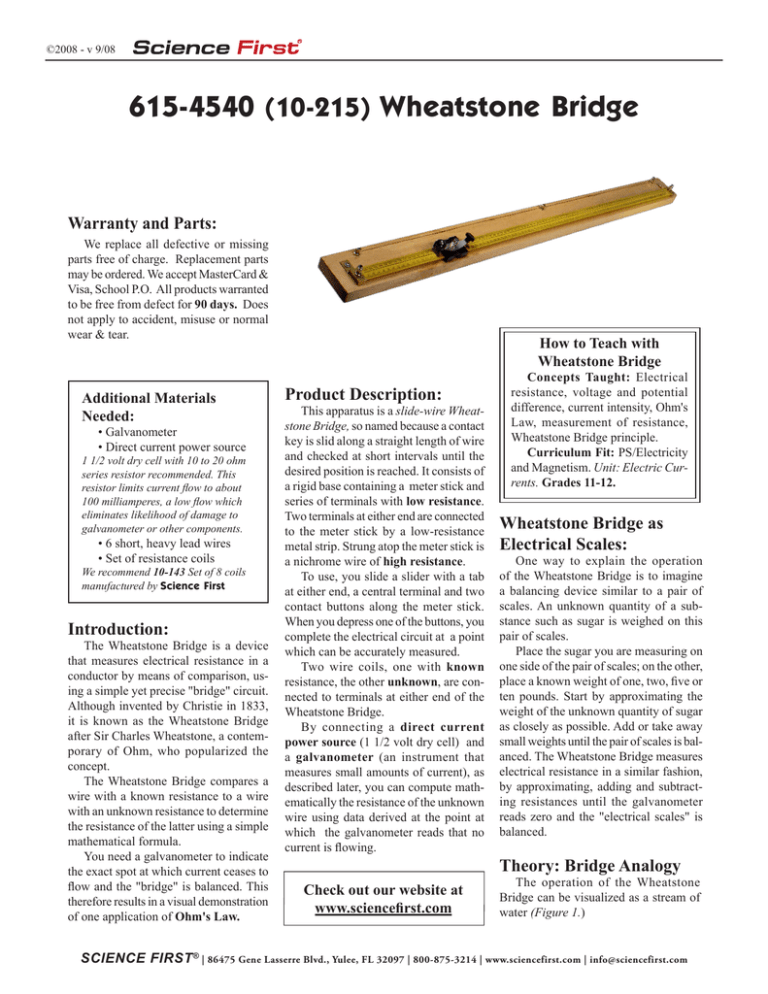
©2008 - v 9/08
615-4540 (10-215) Wheatstone Bridge
Warranty and Parts:
We replace all defective or missing
parts free of charge. Replacement parts
may be ordered. We accept MasterCard &
Visa, School P.O. All products warranted
to be free from defect for 90 days. Does
not apply to accident, misuse or normal
wear & tear.
Additional Materials
Needed:
• Galvanometer
• Direct current power source
1 1/2 volt dry cell with 10 to 20 ohm
series resistor recommended. This
resistor limits current flow to about
100 milliamperes, a low flow which
eliminates likelihood of damage to
galvanometer or other components.
• 6 short, heavy lead wires
• Set of resistance coils
We recommend 10-143 Set of 8 coils
manufactured by Science First
Introduction:
The Wheatstone Bridge is a device
that measures electrical resistance in a
conductor by means of comparison, using a simple yet precise "bridge" circuit.
Although invented by Christie in 1833,
it is known as the Wheatstone Bridge
after Sir Charles Wheatstone, a contemporary of Ohm, who popularized the
concept.
The Wheatstone Bridge compares a
wire with a known resistance to a wire
with an unknown resistance to determine
the resistance of the latter using a simple
mathematical formula.
You need a galvanometer to indicate
the exact spot at which current ceases to
flow and the "bridge" is balanced. This
therefore results in a visual demonstration
of one application of Ohm's Law.
How to Teach with
Wheatstone Bridge
Product Description:
This apparatus is a slide-wire Wheatstone Bridge, so named because a contact
key is slid along a straight length of wire
and checked at short intervals until the
desired position is reached. It consists of
a rigid base containing a meter stick and
series of terminals with low resistance.
Two terminals at either end are connected
to the meter stick by a low-resistance
metal strip. Strung atop the meter stick is
a nichrome wire of high resistance.
To use, you slide a slider with a tab
at either end, a central terminal and two
contact buttons along the meter stick.
When you depress one of the buttons, you
complete the electrical circuit at a point
which can be accurately measured.
Two wire coils, one with known
resistance, the other unknown, are connected to terminals at either end of the
Wheatstone Bridge.
By connecting a direct current
power source (1 1/2 volt dry cell) and
a galvanometer (an instrument that
measures small amounts of current), as
described later, you can compute mathematically the resistance of the unknown
wire using data derived at the point at
which the galvanometer reads that no
current is flowing.
Concepts Taught: Electrical
resistance, voltage and potential
difference, current intensity, Ohm's
Law, measurement of resistance,
Wheatstone Bridge principle.
Curriculum Fit: PS/Electricity
and Magnetism. Unit: Electric Currents. Grades 11-12.
Wheatstone Bridge as
Electrical Scales:
One way to explain the operation
of the Wheatstone Bridge is to imagine
a balancing device similar to a pair of
scales. An unknown quantity of a substance such as sugar is weighed on this
pair of scales.
Place the sugar you are measuring on
one side of the pair of scales; on the other,
place a known weight of one, two, five or
ten pounds. Start by approximating the
weight of the unknown quantity of sugar
as closely as possible. Add or take away
small weights until the pair of scales is balanced. The Wheatstone Bridge measures
electrical resistance in a similar fashion,
by approximating, adding and subtracting resistances until the galvanometer
reads zero and the "electrical scales" is
balanced.
Theory: Bridge Analogy
Check out our website at
www.sciencefirst.com
The operation of the Wheatstone
Bridge can be visualized as a stream of
water (Figure 1.)
SCIENCE FIRST ® | 86475 Gene Lasserre Blvd., Yulee, FL 32097 | 800-875-3214 | www.sciencefirst.com | info@sciencefirst.com
©2008 - v 9/08
potential difference, from A to C equals
that from A to D; the voltage drop from
C to B equals that from D to B.
Figure 3 shows a typical Wheatstone
Bridge electrical circuit.
D
A
(E2) I1
(E1) I1
C
B
R1
R2
Figure 1
The stream divides at point A, forming an island, and reunites at B. C and D
at opposite sides of the island represent
a special case in which, if a ditch is dug
between pints C and D, there will be no
water flowing through the ditch. This is
because these points lie at exactly the
same level. At this point the water pressure of the two streams is also the same
- otherwise the water would flow toward
the point with lower pressure.
The fall or difference in elevation
of the two streams must be equal at the
point where the ditch is dug. The fall of
the stream from A to C equals that from
A to D.
Since the streams rejoin at B, again a
spot where the level of water pressure is
identical for both streams, the fall from D
to B is equal to the fall from C to B.
Figure 2 shows the electrical equivalent of the bridge analogy.
A
D
C
B
Figure 2
The electrical current divides - not
necessarily equally - at A and reconnects
at B. From any point C on one branch of
the conductor, a corresponding point D
exists in which no current flows between
C and D. C and D therefore have the same
electrical potential. The voltage drop, or
R3
Rx
I2 (Ex)
I2 (E3)
Power Source
G = galvanometer
R = Resistances
Rx = unknown
R3 = known
I = current
E = Voltage
Arrows indicate
current flow
Figure 3
This circuit is a "bridge" because the
parallel circuits ACB and ADB are linked
by the circuit CD that connects the galvanometer G. When resistances are adjusted
so that C and D are at the same potential,
the bridge is considered balanced. This
occurs when the galvanometer reads zero,
because otherwise electrons would drift
through the galvanometer and show a
current still flowing.
R1, R2, R3 and Rx indicate the various resistances at different parts of the
Wheatstone Bridge circuit. R3 and Rx
are resistance coils connected to the
Wheatstone Bridge; R3 is known and
Rx unknown. In Figure 3, R1 and R2 are
lengths of the same piece of wire; in this
case, a piece of nichrome wire of about 3
ohms total resistance, one meter in length
(Figure 4.)
I1 and I2 are represented by arrows
parallel to line segments AC, CB, AD
and DB. They symbolize electrical current flowing through both branches of the
bridge circuit.
Ohm's Law states that E = IR, where
E = voltage, I = current and R = Resistance. The fall of potential E is equal
from A to C and from A to D. Therefore
the current I1 is the same from A to C
and from C to B. Since the bridge is balanced, there is no current flow from C to
D. All current flowing from A to C must
continue from C to B as no other pathway
exists. Similarly, the current I2 is the
same from A to D and from D to B.
Therefore, E1 = E3, and E2 = Ex.
Since E = IR,
R1 I1 = R3 I2 and
(1)
R2 I1 = Rx I2
(2)
Dividing one equation by the other,
R1 I1
=
R3 I2
R2 I1
Rx I2 or
R1 = R3
R2
Rx
(3)
Since the values of R1, R2 and R3 are
known,
Rx = R3 R2
R1
(4)
In this manner an unknown resistance
can be measured by comparing it with 3
known resistances.
How To Use:
Refer to Figures 4 and 5. Figure 4
depicts electrical connections, represented by lines linking components. The
direction of current flow is shown by
arrows. Figure 5 labels other parts of the
Wheatstone Bridge.
1. Connect dry cell to 2 terminals at
either end, points A and B on the diagrams. They are electrically connected by
means of a metal strip to a length of high
resistance nichrome wire stretched on top
of a meter stick. This wire is represented
electrically as the circuit ACB. It is assumed to have uniform resistance.
2. Connect galvanometer by means
of two wires to points P and D. P is a
terminal in the middle of the slider. C
is the point on the slider that contacts
the wire at the point where the bridge is
balanced; C can be moved by means of
the slider. D, a fixed point, is a terminal
located at the midpoint along the outer
edge. This is the edge that does not contain the meter stick.
Connecting the direct current power source
causes current to flow from A to B along the
parallel circuits ACB and ADB.
3. Choose two resistance coils, R3
(known) and Rx (unknown), so that R3
SCIENCE FIRST ® | 86475 Gene Lasserre Blvd., Yulee, FL 32097 | 800-875-3214 | www.sciencefirst.com | info@sciencefirst.com
©2008 - v 9/08
is roughly similar to Rx. Connect
these resistance coils to terminal pairs
1,2 and 3,4 at either end of Wheatstone
Bridge with short, heavy lead wires.
Terminals 1 through 4 are electrically
connected to points A, D and B. Tip: The
instructor should try to balance the
bridge in the vicinity of 50 cm. This is
to help prevent measurement errors.
Values R1 and R2 are different lengths
of the same piece of wire, specifically 2
segments of meter-long nichrome wire on
either side of the slider, at whatever point
the slider is positioned. R1 will include all
the resistance from point A to point C,
including contact resistances and the resistance of the lead wires. R2 will include
all the resistance from C to B.
4. Position slider at about 50 cm.
Tap one of contact buttons to check
reading on the galvanometer. Handle
the contact button lightly to safeguard
the sensitivity of the galvanometer. Watch
the direction in which the galvanometer
tends to deflect rather that waiting for it
to settle on a specific value, for the same
reason.
5. Important! Protect the accuracy
of your galvanometer by making sure
the battery key is closed before the galvanometer key and opened afterward.
Otherwise the needle on the galvanometer may slam and affect its reliability.
6. Move the slider a considerable
distance. Tap the contact button again.
Raise the contact button as you move the
slider to prevent scraping off a portion of
the slide wire. Observe the direction of
deflection of the galvanometer key. If it is
larger than the first time, move the slider
in the opposite direction. Use the process
of successive approximation, always with
light taps on the contact button, until you
obtain a reading near zero.
6. When near zero, use a move deliberate touch on the contact button to obtain
a final reading on the galvanometer.
When the galvanometer reds zero, the
bridge circuit is balanced. Record this
position in cm on the meter stick.
If the known resistance, R3, registers too
close to either end , choose a larger or
smaller resistance. The apparatus works
best when values range near the midpoint
of 50 cm. As in the analogy of weighing on
scales, a letter would not be weighed on a
bathroom scale.
F
H
C
I1 = R1
(1) (2)
A
Figure 4
D I2 = R2
G
R3
Rx
ST
S
B
(1,2) (3,4) = terminal pairs
I = current
A,B,C,D= points on bridge circuit
corresponding to similarly labeled
points on Figures 1, 2 3
F = DC Power Source
G = Galvanometer
H = Slider
Rx - Resistance, unknown
R3 = Resistance, known
T
(3)
(4)
S
H
C
A
Figure 5
B
W
Y
P
W = Wire
Y = Contact Buttons
P = Slider Terminal H = Slider
7. Record values R1 and R2. R1 is the
value indicated on the meter stick by the
slider tab at the point where the galvanometer reads zero. Subtract this figure
from the total length of the nichrome wire
- 100 cm - to yield the value R2.
For example, a measurement of 56.2 cm for
R1, leaving 100 - 56.2, r 43.8, for R2.
8. Determine relationship between
resistance and length of wire. Resistance, measured in ohms, is equated
with specific lengths of wire, measured
in centimeters. The relationship between
the two is one of proportion depending
on four factors:
• Material of which it is composed in this case, nichrome
• Length of wire
• Diameter of wire
• Temperature of wire
M
M = Meter Stick
T = R2
S = R1
Assumptions made: We assume the
nichrome wire has uniform resistance
along its entire length. We also assume
all factors, except length, remain equal
during each operation. The only factor
that varies, therefore, is the length of the
wire, which will be directly proportional
to the resistance offered.
For example, a wire 20 feet long offers 4
times the resistance of a wire 5 feet long.
Figure 5 represents R1 and R2 by distances S and T. S is the length from A to
C; T the length from C to B.
(The resistances of the contacts are
much lower than that of the slide wire.
It is assumed that the resistances of the
electrical contacts between A and position
0 cm on the meter stick, and between B and
position 100 cm on the meter stick, are so
negligible as to equal zero.)
SCIENCE FIRST ® | 86475 Gene Lasserre Blvd., Yulee, FL 32097 | 800-875-3214 | www.sciencefirst.com | info@sciencefirst.com
©2008 - v 9/08
Since S = R1 and T = R2 and the values
S and T are known values read in cm off
the meter stick, the following formula
calculates the unknown resistance:
Rx = R3S
(5)
T
In this example, where R1 = 56.2 cm
and R2 = 43.8, assume R3 (the known resistance coil) equals 8 ohms. Therefore,
Rx = R3S
T
= 8 (56.2)
43.8
= 449.6
43.8
= 10.26 ohms
In this manner the Wheatstone Bridge
uses one known resistance coil, a meter
stick, dry cell and galvanometer to determine the value of the second, unknown,
resistance coil by means of comparison.
Measurement Errors:
It is important to minimize errors
while using the Wheatstone Bridge. It is
assumed in the procedure above that the
contact resistances and resistance of lead
wires approximate zero. This is primarily
true if all resistances R1, R2, R3 and Rx are
large. If they are small, the resistances
of the contacts and lead wires become
increasingly important.
To reduce measurement errors when
resistances are small:
1. Select an unknown resistance
roughly similar to the known resistance
and not too small to be easily measured.
2. If the point at which the bridge is
balanced lies too close to either end of the
meter stick, substitute the next higher or
lower resistance until the point falls as
near the center of the scale.
3. Make sure all contacts are good.
Use large, heavy connecting wires. Check
that all terminals are clean and tight.
One remedy for measurement errors is
to interchange the known and unknown
resistances and to average the values of
the unknown resistance that result.
A similar procedure can also be used
to minimize the errors inherent in the
design of the Wheatstone Bridge. Figure 6 illustrates where contact and line
errors occur. Contact errors, which are
those involving resistance in the terminal
connections, occur at points E, F, G, H,
I J, K and Y. These are points at which
lead wires or metal conductors provide
the necessary connections. Line errors
involve resistance in wires and occur
from E to F, F to G, G to H, I to J and
K to L.
To correct for these various contact
the line errors, the lead wire from the
galvanometer (Z in Figure 6) can be
connected to terminals other than the terminal in the midpoint of the meter stick.
For example, connect lead Z to terminal
F. Adjust slider until contact with the
nichrome wire results in a zero reading
on the galvanometer. Record on meter
scale. For the purposes of this example,
assume a value of 1.2 cm.
Repeat procedure by connecting lead
wire Z to terminals G, J and K. The values
obtained are:
F = 1.2cm
G = 43.8
J = 44.8
K = 98.4
Assume a known resistance R3 of 8
ohms. Subtracting 1.2 from 43.8 results in
the distance representing R1 in the equation. Subtract 44.8 from 98.4 to obtain the
distance representing R2.
Calculate Rx as follows:
The error in this example is not large,
but if the unknown resistance Rx were
small compared to the resistance of leads
I, J and L, K, large relative errors would
result.
Use the above procedure when determining the value of small unknown
resistances.
Related Products:
These products may be ordered from most
science distributors. For more information
contact manufacturer Science First.
615-4500 Resistance Coils - 8 known
resistances for use with Wheatstone Bridge.
Each labeled coil has 2 brass terminals. Includes: 30 gauge nickel silver, 2 of 200 cm;
160 cm; 120 cm; 80 cm; 40 cm.
615-4545 Unknown Resistance -For
use with Wheatstone Bridge. Assign different "unknowns" to lab groups. 9 precision
1% 1/4 watt resistors range from 1 to 100
kilohm. Each will survive up to 12 volts direct
application.
Visit us at at
www.sciencefirst.com
Without corrections
Rx = R
R32 R1
= 8 (100-43.8)
43.8
= 10.26 ohms
With corrections
Rx = R3 (relevant part of S)
(relevant part of T)
= 8(98.4 - 44.8)
(43.8 - 1.2)
= 10.07 ohms
P/N 24-10215
© Science First/Morris & Lee. Science First
is a registered trademark of Morris & Lee.
All rights reserved.
Y
X
L
K
J
H
G
E
F
D = Terminal to which lead
wire Z normally connects
Figure 6
Z
SCIENCE FIRST ® | 86475 Gene Lasserre Blvd., Yulee, FL 32097 | 800-875-3214 | www.sciencefirst.com | info@sciencefirst.com

